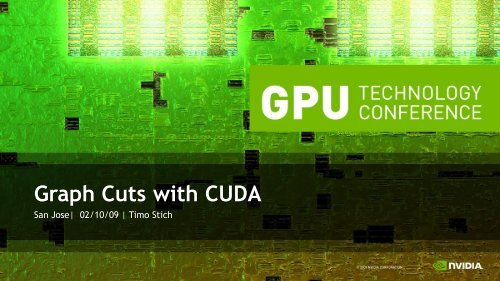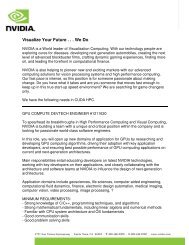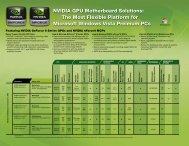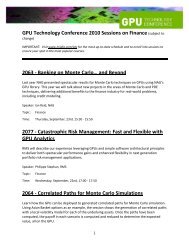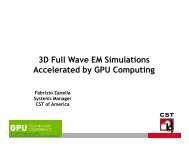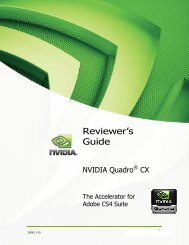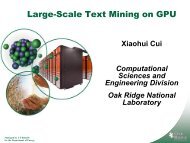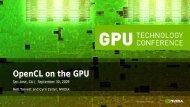Graph Cuts with CUDA
Graph Cuts with CUDA
Graph Cuts with CUDA
Create successful ePaper yourself
Turn your PDF publications into a flip-book with our unique Google optimized e-Paper software.
<strong>Graph</strong> <strong>Cuts</strong> <strong>with</strong> <strong>CUDA</strong><br />
San Jose| 02/10/09 | Timo Stich
Outline<br />
• Introduction<br />
• Algorithms to solve <strong>Graph</strong> <strong>Cuts</strong><br />
• <strong>CUDA</strong> implementation<br />
• Image processing application<br />
• Summary
Problems solvable <strong>with</strong> <strong>Graph</strong>cuts<br />
Stereo Depth Estimation Binary Image Segmentation<br />
Photo Montage (aka Image Stitching)<br />
Source: MRF Evaluation, Middlebury College
Energy Minimization<br />
• <strong>Graph</strong>cut finds global minimum<br />
Sum over all Pixels of an Image<br />
E(<br />
L)<br />
x<br />
D<br />
x<br />
( L<br />
x<br />
Data Term:<br />
Measures fitting of<br />
label to pixel<br />
)<br />
( x,<br />
y)<br />
Sum over all neighborhoods<br />
V<br />
(|<br />
L<br />
x<br />
L<br />
y<br />
|)<br />
Neighborhood Term:<br />
Penalizes different labelings<br />
for neighbors
Example:<br />
Binary Segmentation Problem<br />
User marks some pixels as<br />
Background and Foreground<br />
0 0 0 0<br />
? ? ? ?<br />
? ? ? ?<br />
? ? ? 1<br />
Compute for all pixels if they<br />
are Background or Foreground
Building a Flow <strong>Graph</strong> for the Problem<br />
Pixels<br />
Da<br />
( 1)<br />
Source<br />
D b(<br />
1)<br />
D ( 1)<br />
c<br />
V a,b<br />
( 1)<br />
V b,c<br />
( 1)<br />
V c,d<br />
( 1)<br />
Vd<br />
,e ( 1)<br />
a b<br />
c<br />
d e<br />
Da<br />
( 0)<br />
Db<br />
( 0)<br />
Dc<br />
( 0)<br />
Sink<br />
Dd<br />
( 1)<br />
Dd<br />
( 0)<br />
De<br />
( 1)<br />
De<br />
( 0)<br />
....
Maximum Flow = Minimum Cut<br />
Source<br />
Pixels a b<br />
c<br />
d e ....<br />
Sink
Pixels<br />
<strong>Graph</strong> Cut Solution<br />
Source<br />
Sink<br />
....
<strong>Graph</strong> Cut Solution<br />
Input Result
<strong>Graph</strong> Cut Algorithms<br />
• Ford-Fulkerson<br />
– Find augmenting paths from source to sink<br />
– Global scope, based on search trees<br />
– Most used implementation today by Boykov et al.<br />
• Goldberg-Tarjan (push-relabel)<br />
– Considers one node at a time<br />
– Local scope, only direct neighbors matter<br />
– Inherently parallel, good fit for <strong>CUDA</strong>
Push-Relabel in a nutshell<br />
• Some definitions<br />
– Each node x:<br />
• Has excess flow u(x) and height h(x)<br />
• Outgoing edges to neighbors (x,*) <strong>with</strong> capacity c(x,*)<br />
– Node x is active: if u(x)> 0 and h(x)< HEIGHT_MAX<br />
– Active node x<br />
• can push to neighbor y: if c(x,y) > 0, h(y) = h(x) – 1<br />
• is relabeled: if for all c(x,*) > 0, h(*) >= h(x)
Push Pseudocode<br />
void push(x, excess_flow, capacity, const height)<br />
if active(x) do<br />
done<br />
foreach y=neighbor(x)<br />
end<br />
if height(y) == height(x) – 1 do // check height<br />
done<br />
flow = min( capacity(x,y), excess_flow(x)); // pushed flow<br />
excess_flow(x) -= flow; excess_flow(y) += flow; // update excess flow<br />
capacity(x,y) -= flow; capacity(y,x) += flow; // update edge cap.
Relabel Pseudocode<br />
void relabel(x, height, const excess_flow, const capacity)<br />
if active(x) do<br />
done<br />
my_height = HEIGHT_MAX; // init to max height<br />
foreach y=neighbor(x)<br />
end<br />
if capacity(x,y) > 0 do<br />
my_height = min(my_height, height(y)+1); // minimum height + 1<br />
done<br />
height(x) = my_height; // update height
Push-Relabel Pseudocode<br />
while any_active(x) do<br />
done<br />
foreach x<br />
end<br />
relabel(x);<br />
foreach x<br />
end<br />
push(x);
<strong>Graph</strong> setup<br />
Excess Flow Height<br />
3<br />
Source<br />
9 5 6<br />
3/3 3/3 4/4 1/1<br />
0/0 0/0<br />
0/0<br />
0/0 0/0<br />
10<br />
2 1<br />
Sink<br />
8<br />
9<br />
2<br />
1<br />
1
Direct Push<br />
10 - 3 = -7<br />
3<br />
Source<br />
9 10 6<br />
3/3 3/3 4/4 1/1<br />
-7/0 0/0 0/0<br />
0/0<br />
0/0 0/0<br />
10<br />
2 1<br />
Sink<br />
8<br />
9<br />
2<br />
Total flow = 30
Initialized<br />
HEIGHT_MAX = 5<br />
Source<br />
3/3 3/3 4/4 1/1<br />
-7/0 7/0<br />
4/0<br />
-2/0 -7/0<br />
active<br />
Sink<br />
Total flow = 14
After Relabel<br />
Source<br />
3/3 3/3 4/4 1/1<br />
-7/0 7/1<br />
4/1<br />
-2/0 -7/0<br />
Sink<br />
Total flow = 14
After Push<br />
Source<br />
6/0 3/3 0/8 1/1<br />
-4/0 4/1<br />
0/1<br />
2/0 -7/0<br />
Sink<br />
Total flow = 19
2 nd iteration<br />
Source<br />
6/0 3/3 0/8 1/1<br />
-4/0 4/1<br />
0/1<br />
2/0 -7/0<br />
Sink<br />
Total flow = 19
After Relabel<br />
Source<br />
6/0 3/3 0/6 1/1<br />
-4/0 4/2<br />
0/1<br />
2/1 -7/0<br />
Sink<br />
Total flow = 19
After Push<br />
Source<br />
6/0 0/6 0/6 0/2<br />
-4/0 1/2<br />
3/1<br />
1/1 -6/0<br />
Sink<br />
Total flow = 20
After 3 more Iterations, Terminated<br />
Source<br />
6/0 0/6 0/6 0/2<br />
-4/0 1/5<br />
3/5<br />
1/5 -6/0<br />
Sink<br />
Total flow = 20
Inverse BFS from Sink<br />
Source<br />
6/0 0/2<br />
-4/0 X 1/5<br />
3/5<br />
1/1 X -6/0<br />
Sink<br />
Total flow = 20
<strong>Graph</strong> Cut and Solution<br />
3<br />
Source<br />
9 5 6<br />
3 3 4 1<br />
a b<br />
c<br />
d e<br />
10<br />
2 1<br />
Sink<br />
8<br />
9<br />
2<br />
Total flow = 20<br />
Minimum Cut = 20 = Maximum Flow
<strong>Graph</strong> <strong>Cuts</strong> for Image Processing<br />
• Regular <strong>Graph</strong>s <strong>with</strong> 4-Neighborhood<br />
• Integers<br />
• Naive approach<br />
– One thread per node<br />
– Push Kernel<br />
– Relabel Kernel<br />
S<br />
T
<strong>CUDA</strong> Implementation<br />
• Datastructures<br />
– 4 WxH arrays for residual edge capacities<br />
– 2 WxH array for heights (double buffering)<br />
– WxH array for excess flow
Push Data Access Patterns<br />
• Read/Write: Excess Flow, Edge capacities<br />
• Read only : Height<br />
Excess Flow Data
Relabel Data Access Patterns<br />
• Read/Write: Height (Texture, double buffered)<br />
• Read only : Excess Flow, Edge capacities<br />
Height Data
Data Access Patterns<br />
• Push does scattered write:<br />
Needs global atomics to avoid RAW Hazard!
Naive <strong>CUDA</strong> Implementation<br />
• Iterative approach:<br />
• Repeat<br />
– Push Kernel (Updates excess flow & edge capacities)<br />
– Relabel Kernel (Updates height)<br />
• Until no active pixels are left
Naive <strong>CUDA</strong> Implementation<br />
• Both kernels are memory-bound<br />
• Observations on the naive implementation<br />
– Push: Atomic memory bandwidth is lower<br />
– Relabel: 1-bit per edge would be sufficient<br />
Addressing these bottlenecks improves overall performance
Push, improved<br />
• Idea:<br />
– Work on tiles in shared memory<br />
• Share data between threads of a block<br />
– Each thread updates M pixels<br />
• Push first M times in first edge direction<br />
• Then M times in next edge direction
Wave Push<br />
Active Thread<br />
Push direction<br />
Excess Flow Data-Tile in Shared Memory<br />
M<br />
ef = 0;<br />
for k=0...M-1<br />
ef += s_ef(k)<br />
flow = min(right(x+k),ef)<br />
right(x+k)-=flow;<br />
s_ef(k)=ef-flow;<br />
ef = flow;<br />
end
Wave Push<br />
Active Thread<br />
Push direction<br />
Flow is carried along by each thread<br />
ef = 0;<br />
for k=0...M-1<br />
ef += s_ef(k)<br />
flow = min(right(x+k),ef)<br />
right(x+k)-=flow;<br />
s_ef(k)=ef-flow;<br />
ef = flow;<br />
end
Wave Push<br />
Active Thread<br />
Push direction<br />
ef = 0;<br />
for k=0...M-1<br />
ef += s_ef(k)<br />
flow = min(right(x+k),ef)<br />
right(x+k)-=flow;<br />
s_ef(k)=ef-flow;<br />
ef = flow;<br />
end
Wave Push<br />
Active Thread<br />
Push direction<br />
Border
Wave Push<br />
Active Thread<br />
Push direction<br />
Do the same for other directions
Wave Push<br />
• After tile pushing, border is added<br />
• Benefits<br />
– No atomics necessary<br />
– Share data between threads<br />
– Flow is transported over larger distances
Relabel<br />
• Binary decision: capacity > 0 ? 1 : 0<br />
• Idea: Compress residual edges as bit-vectors<br />
– Compression computed during push
Relabel<br />
5<br />
0<br />
3<br />
9<br />
0<br />
0<br />
1<br />
7<br />
• Compression Ratio: 1:32 (int capacities)<br />
1<br />
0<br />
1<br />
1<br />
0<br />
0<br />
1<br />
1
<strong>CUDA</strong> Implementation<br />
• Algorithmic observations<br />
– Most parts of the graph will converge early<br />
– Periodic global relabeling significantly reduces<br />
necessary iterations
Tile based push-relabel<br />
80%<br />
70%<br />
60%<br />
50%<br />
40%<br />
30%<br />
20%<br />
10%<br />
0%<br />
Active Pixels per Iteration<br />
1 2 3 4 5 6 7 8 9
Tile based push-relabel<br />
• Split graph in NxN pixel tiles (32x32)<br />
• If any pixel is active, the tile is active<br />
Tiles<br />
Pixels
Tile based push-relabel<br />
• Repeat<br />
– Build list of active tiles<br />
– For each active tile<br />
• Push<br />
• Relabel<br />
• Until no active tile left
Global Relabel<br />
• Local relabel is a bad heuristic for long distance<br />
flow transportation<br />
– Unnecessary pushing of flow back and forth<br />
• Global relabel is exact<br />
– Computes the correct geodesic distances<br />
– Flow will be pushed in the correct direction<br />
– Downside: costly operation
Global Relabel<br />
• BFS from sink<br />
– First step implicit -> multi-sink BFS<br />
• Implemented as local operator:
Global Relabel<br />
• Mechanisms from Push-Relabel can be reused:<br />
– Wave Updates<br />
– Residual <strong>Graph</strong> Compression<br />
– Tile based
Global Relabel<br />
• Initialize all pixels:<br />
– <strong>with</strong> flow < 0 to 0 (multi-sink BFS)<br />
– <strong>with</strong> flow >= 0 to infinity<br />
• Compress residual graph<br />
• Build active tile list<br />
• Repeat<br />
– Wave label update<br />
• Until no label changed
Final <strong>CUDA</strong> <strong>Graph</strong>cut<br />
• Repeat<br />
– Global Relabel<br />
– For H times do<br />
• Build active tile list<br />
• For each tile do push-relabel<br />
• Until no active tile
Results<br />
• Comparison between Boykov et al. (CPU),<br />
Cuda<strong>Cuts</strong> and our implementation<br />
– Intel Core2 Duo E6850 @ 3.00 GHz<br />
– NVIDIA Tesla C1060<br />
Dataset Boykov<br />
(CPU)<br />
Cuda<strong>Cuts</strong><br />
(GPU)<br />
Our<br />
(GPU)<br />
Flower (600x450) 191 ms 92 ms 20 ms 9.5x<br />
Sponge (640x480) 268 ms 59 ms 14 ms 19x<br />
Person (600x450) 210 ms 78 ms 35 ms 6x<br />
Average speedup over CPU is 10x<br />
Speedup<br />
Our vs CPU
Results<br />
Runtime (ms)<br />
8000<br />
7000<br />
6000<br />
5000<br />
4000<br />
3000<br />
2000<br />
1000<br />
0<br />
Average Speedup of 8.5 x<br />
0 2 4 6 8 10 12 14<br />
Image Size (Mega Pixels)<br />
Boykov et al (CPU)<br />
Our <strong>CUDA</strong> Impl. (GPU)
Example Application: GrabCut
GrabCut Application<br />
(Siggraph 2004 paper)<br />
• Based on Color models for FG and BG<br />
– User specifies a rectangle around the object to cut<br />
– Initialize GMM model of FG and BG colors<br />
– <strong>Graph</strong> Cut to find labeling<br />
– Use new labeling to update GMM<br />
– Iterate until convergence<br />
• Full <strong>CUDA</strong> implementation<br />
• Total runtime: ~25 ms per iteration -> 500 ms
Summary<br />
• Introduction to <strong>Graph</strong> <strong>Cuts</strong><br />
• Push-Relabel <strong>CUDA</strong> implementation<br />
– Beats CPU by 8.5 x on average<br />
• Makes full <strong>CUDA</strong> implementation of many image<br />
processing applications possible


